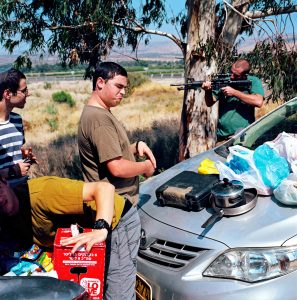Israeli photographer Daniel Tchetchik captures the effect of the Middle Eastern heat on the human condition – for better and for worse…

Credit: Daniel Tchetchik Sunburn
A sheepdog circling its herd on scorched soil, a red-head squinting in the light, a burning car, dazed people making their way through hazy streets – the narrative that binds landscape, man and beast together is … heat. Daniel Tchetchik’s pictures make you feel the burning, scorching, searing sun but also depict a sun giving life and inspiration. Through his lens, the Israeli photographer is investigating, as he puts it, “the effect of the Middle Eastern heat on the human condition.” Or as writer Meir Shalev, who penned a postscript to Tchetchik’s new book Sunburn, says: “There are places in the world where the sun is soft and good … Here the sun is hot, for better and for worse, and the people are also hot, for better and worse.”
Taken at the time leading up to the 2014 war in Gaza, during operation “Protective Edge” and after, Tchetchik, also staff photographer with Israeli daily Ha’aretz, draws you to the sun in all its beauty and mercilessness. Fun and despair, life and death, plenty and barrenness, darkness and light merge. The situations captured are extreme: people line up on gigantic slides waiting to cool off – but there is no water in sight. Others take a dip in the Mediterranean – at once refreshing and dangerous. A green sports ground is located in the midst of the desert. Some folks bask in the sunshine whilst others are desperate for a spot of shade. A dead pigeon pinned to the ground like a fallen Icarus.
The sun has long cast its spell over Tchetchik: “When I was a child, during endless summers, I used sun beams to burn holes and shapes on to old newspapers… Today my magnifying glass is my camera, with every situation I encountered while creating Sunburn, I searched for the distance from the subject that would create the same intense heat that would burn the narrative into this body of work.” Tchetchik was successful; this burn you can feel, just by looking at the pictures.

Credit: Daniel Tchetchik Sunburn
Some photographs appear to have “scars”. A mishap turned out to be a departing point for new ways of seeing and preserving: “After a long day of shooting, I forgot several rolls of film in my car. After developing them, I discovered that the sweltering heat … had left severe burns on my negatives,” explains Tchetchik. “I began experimenting and integrating the sun’s physical effects on my film with the metaphysical attributes I sought to convey.”
But Tchetchik, whose works are part of the collection of The Museum of Tel Aviv and have been shown in the US as well as in India and can be seen in Hamburg and Berlin this summer, also wants to raise questions about the environment, about the way we handle our dwindling resources. Tchetchik’s book Sunburn, recently launched by Kehrer art publishers, is a hot item in itself: beautifully designed, lavishly finished, with the French flap cover unfolding into a poster – or a sunshade…
